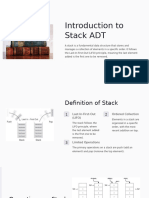0 ratings0% found this document useful (0 votes)
15 viewsStack Data Structure 2024
Uploaded by
cvidad46Copyright
© © All Rights Reserved
Available Formats
Download as PDF, TXT or read online on Scribd
0 ratings0% found this document useful (0 votes)
15 viewsStack Data Structure 2024
Uploaded by
cvidad46Copyright
© © All Rights Reserved
Available Formats
Download as PDF, TXT or read online on Scribd
You are on page 1/ 4
Stack Data Structure
A stack is a linear data structure that
follows the Last In First Out (LIFO)
principle, meaning the last element
added to the stack is the first one to be
removed. It can be visualized like a stack
of plates: you can only add or remove
the top plate.
Basic Operations
1. Push: Adds an element to the top
of the stack.
2. Pop: Removes the element from
the top of the stack.
3. Peek (or Top): Returns the top
element without removing it.
4. isEmpty: Checks if the stack is
empty.
Advantages of Stacks
1. Simplicity: Stacks are simple to
implement and use.
2. Memory Management: They
allow for efficient memory use,
especially in function calls (via call
stack).
3. Backtracking: Useful for
algorithms that require backtracking
(e.g., depth-first search).
4. Function Calls: Supports function
execution and recursion through the
call stack.
5. Reversing Data: Easily reverses
items (e.g., string reversal).
Disadvantages of Stacks
1. Limited Access: Only the top
element can be accessed directly; no
random access to elements.
2. Fixed Size: If implemented with a
fixed size array, it can lead to stack
overflow.
3. No Searching: Inefficient for
searching through elements since it
lacks direct access to items.
4. Inefficiency in Certain Tasks: Not
suitable for problems requiring
frequent additions and removals
from both ends.
In summary, stacks are powerful tools
for specific tasks, especially in managing
function calls and backtracking, but they
come with limitations in flexibility and
access.
You might also like
- What Is A Stack?: Some Key Points Related To StackNo ratings yetWhat Is A Stack?: Some Key Points Related To Stack23 pages
- D.Y.Patil Technical Campus, Talsande Faculty of Engineering & Faculty of Management (Polytechnic)No ratings yetD.Y.Patil Technical Campus, Talsande Faculty of Engineering & Faculty of Management (Polytechnic)21 pages
- Abstract Data Types (ADT's) (Stack) - Anqa#11GreenNo ratings yetAbstract Data Types (ADT's) (Stack) - Anqa#11Green9 pages
- Technical Report Writing For Ca2 Examination: Topic: Stack ImplementationNo ratings yetTechnical Report Writing For Ca2 Examination: Topic: Stack Implementation6 pages
- Introduction-to-Stacks-in-Data-Structures (1)No ratings yetIntroduction-to-Stacks-in-Data-Structures (1)12 pages
- Stacks: Uses and Applications of StacksNo ratings yetStacks: Uses and Applications of Stacks10 pages
- Topic:: Stack Implementation Using Linked ListNo ratings yetTopic:: Stack Implementation Using Linked List14 pages
- Unit - 2 Linear Data Structures (Stacks)No ratings yetUnit - 2 Linear Data Structures (Stacks)15 pages
- What Is A Stack?: Some Key Points Related To StackWhat Is A Stack?: Some Key Points Related To Stack
- D.Y.Patil Technical Campus, Talsande Faculty of Engineering & Faculty of Management (Polytechnic)D.Y.Patil Technical Campus, Talsande Faculty of Engineering & Faculty of Management (Polytechnic)
- Abstract Data Types (ADT's) (Stack) - Anqa#11GreenAbstract Data Types (ADT's) (Stack) - Anqa#11Green
- Technical Report Writing For Ca2 Examination: Topic: Stack ImplementationTechnical Report Writing For Ca2 Examination: Topic: Stack Implementation



























































